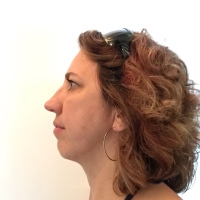How did I arrive at palate expansion as a treatment I wanted to undergo?
This was the result of extensive information gathering and seeking the most holistic approach to my health care as possible. I’ll do my best to describe the conditions that I’ve found myself afflicted with over the years and at present.
Early Medical History
At the age of four, I was diagnosed with asthma and allergies to mold, soy, pollen, pet dander, dust, and lots of other things I don’t remember. To further compound my breathing issues, in my teens I was told that I had a deviated septum. Bronchitis, strep throat, and walking pneumonia were my seasonal companions. In my twenties, I was able to get the asthma and allergies under control with the assistance of Traditional Chinese Medicine. This was a huge success. I was able to finally ditch my inhaler for good. Though my allergies and asthma subsided, I developed migraine headaches that left me seeing stars and nauseated for three days out of every month for the next fifteen years. More often than not, I was bedridden during this time. In my thirties, my TMJ began giving me issues with constant clicking and extreme pain. This is when I began to notice a change in the structure of my face. After several months, TMJ pain stopped, but my jaw had moved back and my bite was completely different. After this, the “I must be getting older” aches and pains arrived: back pain, neck pain, knee pain. Nothing acute, just annoying. I suspected that I had sleep apnea in my early twenties because I snored loudly, drove off the road from drowsiness on more than one occasion, and had been told I stopped breathing in my sleep by more than one person. I never sought long term treatment for any of these conditions for many reasons.
Current Diagnosis
I feel better than I have in years and I’ll share why in another post. Unfortunately, some things still persist. The sleep apnea was diagnosed in June 2015. According to my home sleep study my AHI is 41/hr and my REM sleep is less than 5%. AHI is Apnea Hypopnea Index. Anything above 30 is severe. This measures how many apnea-hypopnea events you experience an hour that tell your central nervous system to wake up and start breathing. 20% REM sleep is ideal. Without REM sleep, the body can’t restore itself. My dentist was completely shocked by the diagnosis because I didn’t present with any of the typical accompanying conditions like diabetes, high blood pressure, or obesity. I’m a 5′-7″ tall woman, 140 lb., relatively fit, perfect blood pressure, and no indication of heart disease or diabetes.
As for my mouth and jaw, I’ll need to reference my records to detail exactly what is out of place, but I’ll attempt to describe this as accurately as I can. Malocclusion with an open bite. My bite is so far off, my teeth only touch in two places, no matter how I move my jaw. I haven’t been able to eat pizza or a sandwich in years without a fork or pulling them apart with my fingers first. Both the maxilla and mandible are underdeveloped with very narrow arches. I have a high vaulted palate, excessive soft tissue in the throat, an enlarged tongue, and tori mandibulari – bone growth in the lower jaw due to stress or pressure. When I first noticed the “tori”, I thought I might have mouth cancer, but no, it’s not that unusual and it’s relatively harmless.
I had braces during my teens to correct malocclusion and an over bite. Prior to orthodontics, I had four bicuspids extracted. In my twenties, I had all four wisdom teeth extracted, two of these were impacted.
I’ll be posting some “before my mRNA appliance” photos as soon as I’m comfortable with the idea. Oh, here they are. The first photo my sister and me. I’m on the left. This photo was taken in my late twenties, prior to having any TMJ issues. You can see the huge difference in my lower jaw compared to my current side profile.




2 thoughts on “Why Palate Expansion as a Treatment Option – Part I”